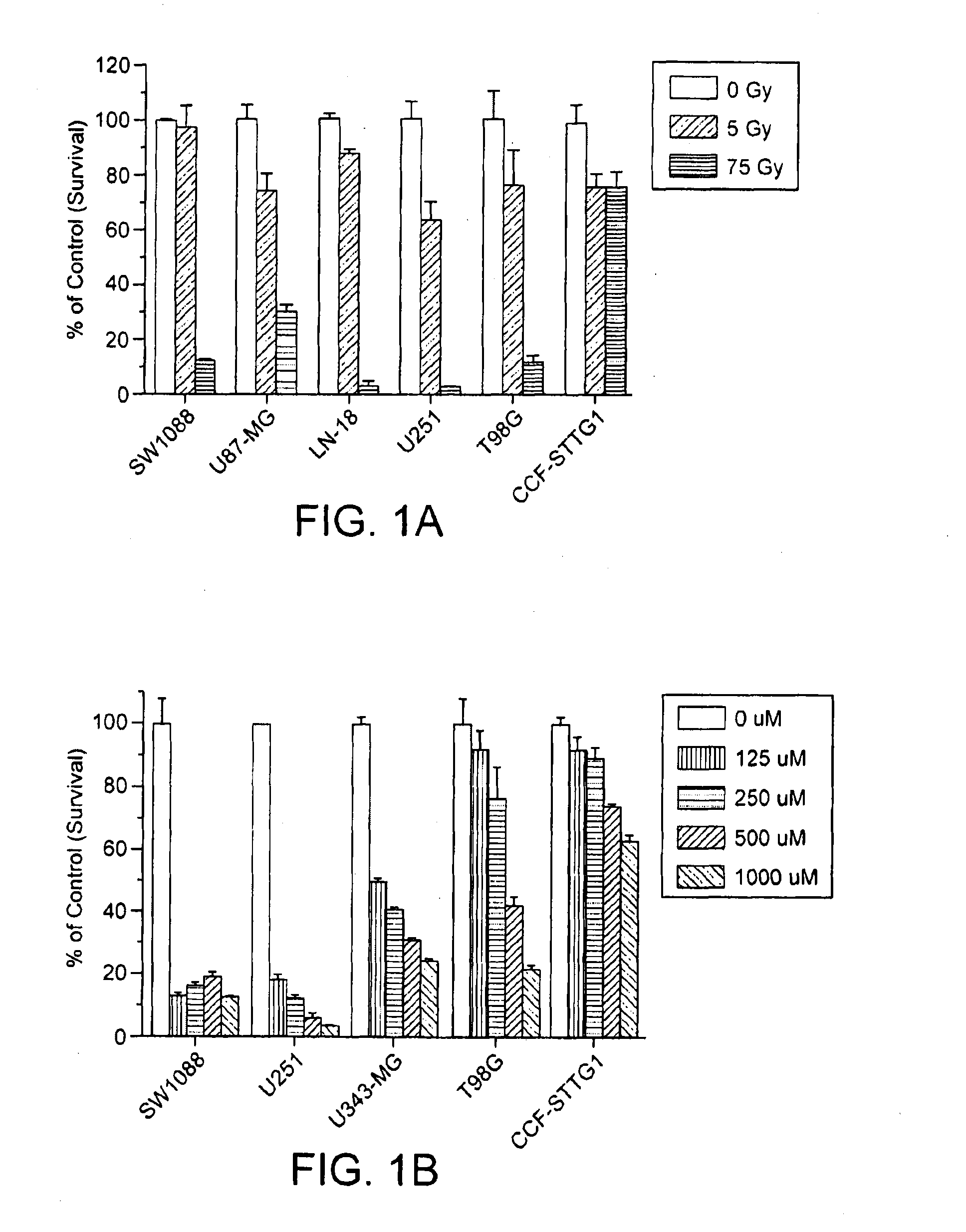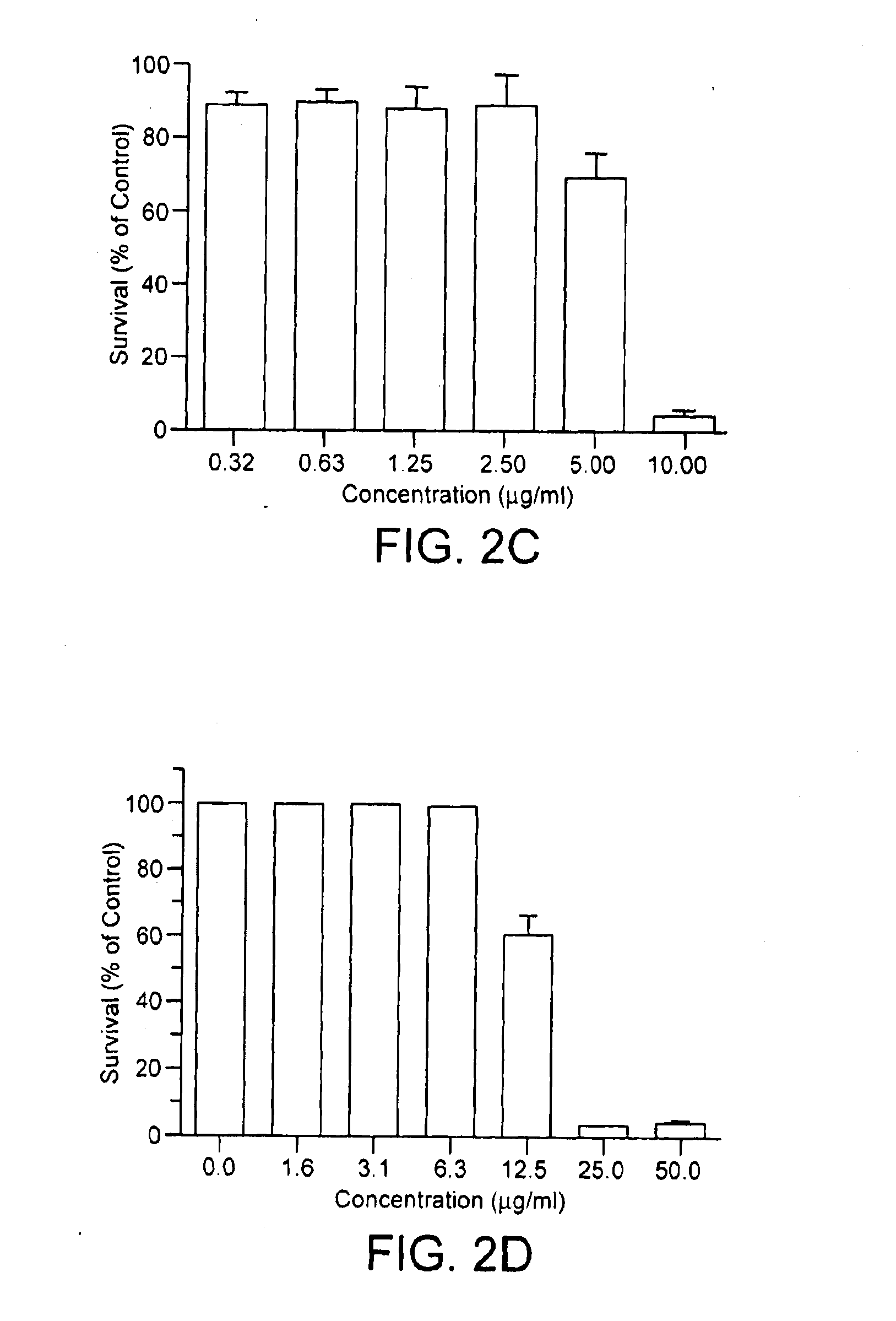Compounds for use in cancer therapy
a cancer therapy and compound technology, applied in the field of cancer therapy, can solve the problems of poor survival rate of patients with newly diagnosed glioblastoma multiforme, the most common malignant glioma, and high resistance to chemotherapy, and achieve the effect of reducing tumor siz
- Summary
- Abstract
- Description
- Claims
- Application Information
AI Technical Summary
Benefits of technology
Problems solved by technology
Method used
Image
Examples
example 1
Selection of Temodar®-Resistant Cell Lines
[0219]A screen for compounds that are cytotoxic to Temodar®-resistant cells was performed. The cytotoxicity of Temodar® and radiation treatment was first determined on established glioma cell lines that express HFE (hemochromatosis gene) polymorphisms. The cells were exposed to a range of doses of Temodar® up to 1000 μM (FIG. 1) or a range of doses of γ-radiation (5 Gy, 75 Gy) for 3-6 days. FIG. 1A shows that the cell line, CCF-STTG1, was the most resistant to radiation. As shown in FIG. 1B, CCF-STTG1 cells were shown to be even more resistant to Temodar® toxicity than T98G and U-343MG, which are glioma cell lines currently used to model Temodar® resistance (51, 52).
example 2
Identification of Chemotype Compound I (CC-I)
[0220]Temodar®-resistant cell lines were used to screen for compounds having the ability to decelerate the growth of, or kill, Temodar®-resistant cells. The efficacy of over 15,000 different compounds in the Drug Discovery Core at Pennsylvania State Hershey Medical Center was tested on Temodar®-resistant human neuroblastoma SH-SY5Y and human glioma CCF-STTG1 cell lines with a colorimetric cytotoxicity assay, the sulforhodamine B (SRB) assay (53). A lead compound, chemotype compound-I (CC-I), shown in FIG. 2A, was identified from the screen.
[0221]CC-I is a thiobarbituric acid analog that is highly toxic to Temodar®-resistant cells. The structure of CC-I is shown in FIG. 2A. FIG. 2B shows that the toxic effect of CC-I was dose-dependent in both Temodar®-resistant and Temodar®-sensitive glioma cells. CC-I was cytotoxic to the Temodar®-resistant CCF-STTG1 glioma cell line, LD50≈1.2 μg / ml (4.3 μM), but was even more cytotoxic to SW-1088 astroc...
example 3
CC-I Inhibits Glioma Cell Tumors in an In Vivo Model
[0222]The efficacy and toxicity of CC-I was tested in vivo using the athymic nude mouse subcutaneous tumor model. Ten million cells of the Temodar®-sensitive (SW1088) or Temodar®-resistant (CCF-STTG1) malignant glioma cell lines were injected into the flank of one-month-old, female athymic nude mice. When the tumor reached 32 mm3 in size (week 1 on graph), CC-I (25 mg / kg) was injected intraperitoneally once a week for 7 weeks. CC-I so completely inhibited the growth of Temodar®-resistant CCF-STTG1 cell tumors that the line indicating the growth of this tumor is not visible on the graph of FIG. 3. In addition, the tumors recur in the Temodar®-resistant glioma injected nude mice when CC-I was discontinued (beyond 7 weeks) (FIG. 3). The body weight of the mice was not affected by CC-I (data not shown). No liver or kidney toxicity was observed in mice treated with CC-I (data not shown).
PUM
| Property | Measurement | Unit |
|---|---|---|
| concentrations | aaaaa | aaaaa |
| particle size | aaaaa | aaaaa |
| particle size | aaaaa | aaaaa |
Abstract
Description
Claims
Application Information
 Login to View More
Login to View More - R&D
- Intellectual Property
- Life Sciences
- Materials
- Tech Scout
- Unparalleled Data Quality
- Higher Quality Content
- 60% Fewer Hallucinations
Browse by: Latest US Patents, China's latest patents, Technical Efficacy Thesaurus, Application Domain, Technology Topic, Popular Technical Reports.
© 2025 PatSnap. All rights reserved.Legal|Privacy policy|Modern Slavery Act Transparency Statement|Sitemap|About US| Contact US: help@patsnap.com



